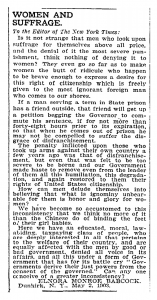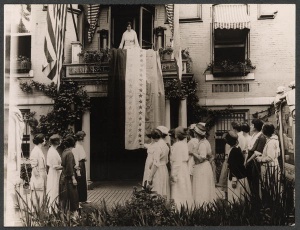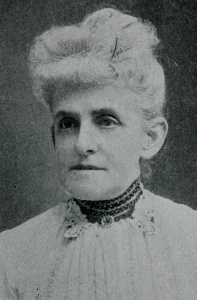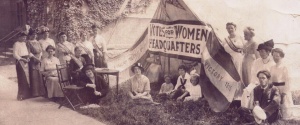
By Sara Kibbler
As the publicist for the National American Woman Suffrage Association (NAWSA) between 1899 and 1906, Elnora Monroe Babcock of Dunkirk, New York wrote and distributed thousands of purposeful newspaper articles advocating women’s suffrage. By her estimate, she sent out approximately 200,000 articles annually.[1] At the turn of the twentieth century, she reported that she was furnishing “150 papers with articles regularly, some every week, others once in two or three weeks. Fifty papers are supplied with one column a week of plate matter,” she continued, “and the American Press Association, the Columbia Press Co., and New York Newspaper Union of New York and A. N. Kellogg and Western Newspaper Union of Chicago are also furnished with suffrage matter.”[2]
Babcock designed her newspaper articles according to which anti-suffrage argument she was disputing. A clippings bureau was employed to track down as many anti-suffrage articles as possible so that NAWSA’s Press Committee could counter the claims directly. During the New York State suffrage convention of 1899, held in Dunkirk, Babcock reported that the clippings bureau was finding more pro-suffrage articles than those against enfranchisement. Even newspapers which initially resisted publishing the women’s suffrage articles had embraced the debate, a notable shift in cultural perception.[3]
In addition to advocating for women’s suffrage, Babcock defended women who had already achieved enfranchisement in the western United States from allegations that they were corrupting the political system. In 1904, Babcock critiqued an argument issued at the time that the corruption of female voters in Colorado was responsible for U.S. Representative John L. Shafroth resigning his post. She did not deny that the woman who was caught committing fraud was wrong, but stressed that she was the first case in states where women had been voting for ten or more years. She claimed that women were being held to a double standard, as men had been perpetrating voter fraud without chastisement or threat of disfranchisement.[4]
In her efforts to support women’s suffrage, Babcock reasoned that requiring a majority of women to support female enfranchisement before passing legislation was an unreasonable demand. She reinforced that declaration by listing the historical benchmarks women had already achieved without requiring a majority, such as the right to higher education, the ability to work in professions then not deemed suitable for women, and property rights.[5] She wrote in 1899: “No great reform has ever been asked for by the masses; the few more progressive ones have seen the needs and obtained the change, then the people have grown to the improved condition.”[6]
Babcock also argued that a majority of the population did not need to approve some of the biggest decisions in United States history, including the signing of the Declaration of Independence or the enfranchisement of African Americans.[7]

While Babcock’s articles included many refined points supporting women’s right to vote, she was not exempt from the troubling narrative shift that occurred in the movement after the Civil War. As many suffragists were also once abolitionists, they had once spoken of suffrage as a universal right of humankind. But after the Thirteenth Amendment enfranchised African American men and excluded women, suffragists spoke less about the right to vote as a human right and began to express why women’s inclusion in politics would have a purifying effect on its corruption. In the process, Elizabeth Cady Stanton and others attempted to exploit public opinion of oppressed groups to gain support for their cause.
Babcock’s arguments, notably, utilized xenophobia to create a stark contrast between newly arrived immigrants who were allowed to vote and the pristine, educated women who were denied the right altogether. She applied this same strategy when she contrasted women with imprisoned persons to underscore the injustice of denying the ballot to law-abiding women.[8] Her objective was to showcase who was granted the right to vote while women struggled against a Congress that refused to enfranchise them. However, these arguments ignored both the contributions of immigrants to the United States and the effective substitution of African American incarceration for slavery in the post-Civil War South.
There is much to learn about the women’s suffrage movement through reading Elnora Babcock’s writings. It is equally important to recognize the folly of “othering” groups of people and understand the origins of the urge to demean.
Links to many of Elnora’s articles are provided below for interested readers.
Selected Writings by Elnora M. Babcock
“No Better Than King John” (1898)
“The Old Story. Reasons Why Some Women do Not Wish Suffrage” (1899)
“‘Twas Ever Thus. Some Conservative Women Have Always Fought Reforms” (1900)
“Three Kinds of Women: Mrs. Carrie Chapman Catt Describes Women in Politics” (1901)
“Women’s Progress. The Few Ask and the Many Receive; This Has Always Been the Rule” (1901)
“Leadville Transformed” (1902)
“A Winning Cause. Equal Suffrage Movement Not Dying, but Gaining in Strength” (1903)
References
[1] Elnora Monroe Babcock, “Political Equality Movement,” in The Centennial History of Chautauqua County, New York (Jamestown: Chautauqua History Company, 1904), 1: 519, https://archive.org/stream/centennialhistor01chau#page/510/mode/2up.
[2] “Suffragists Now in Convention,” November 3, 1899, Miller NAWSA Suffrage Scrapbooks, Scrapbook 3, 49-51, Rare Book and Special Collections Division, Library of Congress, http://hdl.loc.gov/loc.rbc/rbcmil.scrp1005101.
[3] “Suffragists Now in Convention.”
[4] Elnora M. Babcock, “Colorado Election Frauds; Illegal Voting by Men, Not by Women, Caused Shafroth’s Resignation,” The New York Times, March 11, 1904, 7.
[5] Elnora M. Babcock, “Twas Ever Thus: Some Conservative Women Have Always Fought Reforms,” Westfield [N.Y.] Republican, March 28, 1900, 3.
[6] Elnora M. Babcock, “The Old Story: Reasons Why Some Women do Not Wish Suffrage,” Westfield Republican, December 13, 1899, 6.
[7] Elnora M. Babcock, “No Better Than King John: If We Refuse an Act of Simple Justice Until Pressure Becomes Irresistible,” Westfield Republican, August 10, 1898, 2; Babcock, “The Old Story.”
[8] Elnora Monroe Babcock, “Women and Suffrage,” The New York Times, May 10, 1903; Elnora M. Babcock, Speech to the Annual Convention of the Chautauqua County Political Equality Club, October 13, 1892, personal collection of Bill Parks.









